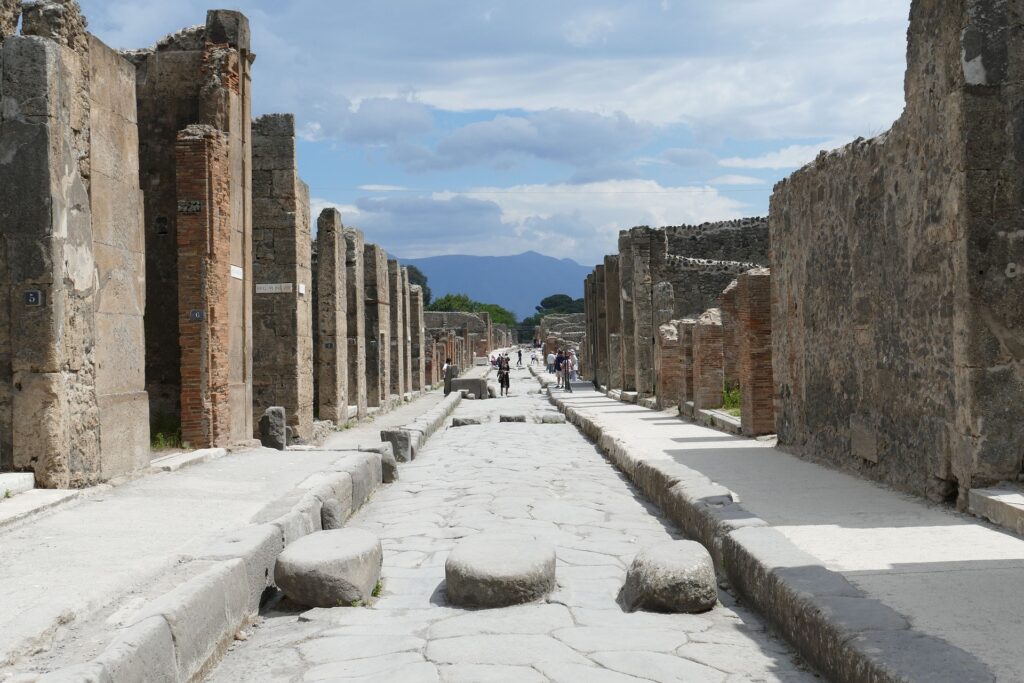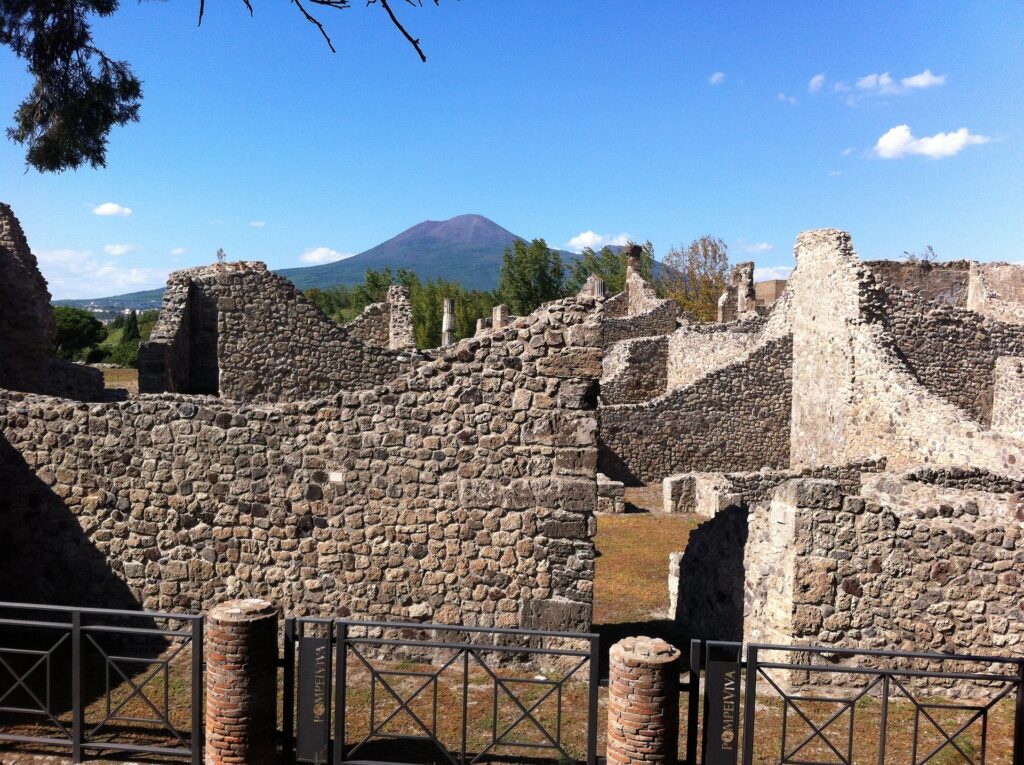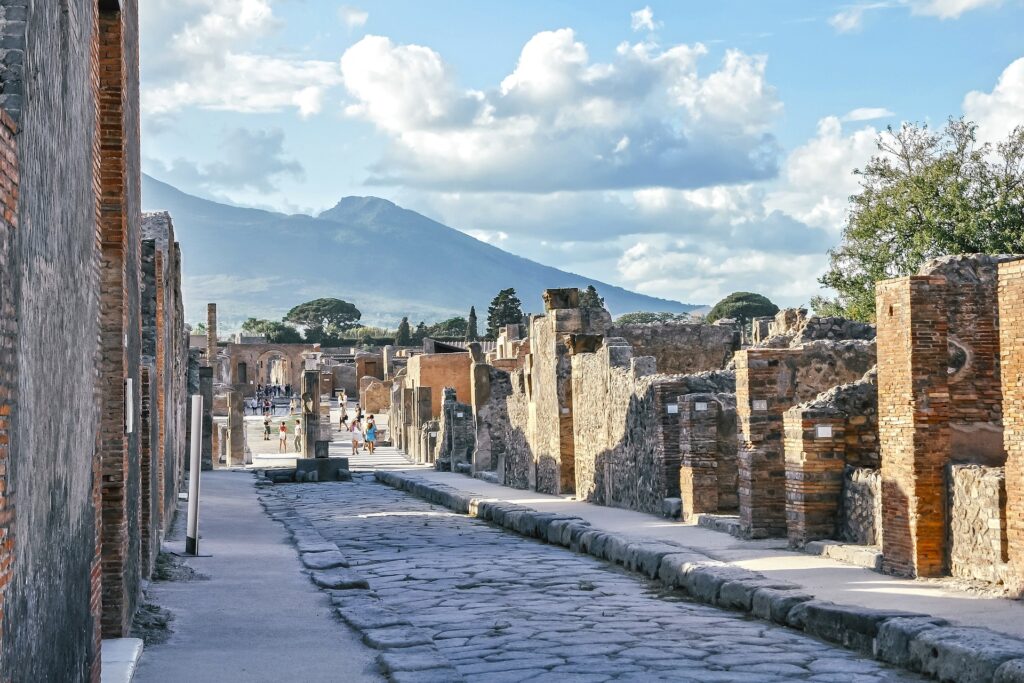Step back in time and embark on a journey to the Ruins of Pompeii, where history and tragedy intertwine to create a captivating and hauntingly beautiful archaeological site. Nestled at the foot of Mount Vesuvius near modern-day Naples in Italy, Pompeii once thrived as a bustling Roman city until it was buried under layers of volcanic ash and preserved for centuries. Today, explorers and history enthusiasts from around the world flock to this UNESCO World Heritage Site to uncover the secrets of a bygone era. Pompeii’s fate was sealed in 79 AD when Mount Vesuvius erupted, burying the city under a blanket of ash and debris. The catastrophic event froze Pompeii in time, preserving its structures, artwork, and even the daily lives of its inhabitants. Rediscovered in the 18th century, the excavations of Ruins of Pompeii have provided invaluable insights into ancient Roman culture, architecture, and urban planning.

As you step through the city’s gates, a world lost in time unfolds before your eyes. Wander through the ancient streets, once filled with the hustle and bustle of everyday life, and experience the eerie feeling of walking in the footsteps of the past. The sprawling Ruins of Pompeii stretch over 170 acres, offering a glimpse into the daily routines, social hierarchies, and artistic achievements of an ancient civilization. One of the most remarkable aspects of Pompeii is its remarkably well-preserved buildings. From palaces and villas to bathhouses and taverns, each structure tells a story, depicting the architectural grandeur and meticulous craftsmanship of the time. Explore the House of the Faun, adorned with intricate mosaics and frescoes that capture scenes of mythological tales. Marvel at the imposing Temple of Apollo, once a center of spiritual devotion and cultural activities. Discover the Amphitheater, a testament to the love of entertainment and the grand spectacles that enthralled the ancient Romans.

The Forum, Pompeii’s vibrant center, served as the heart of the city. Crowded with market stalls, temples, and government buildings, it was a hub of commerce, politics, and social gatherings. Today, while the market stands hollow and the buildings lie in ruins, the Forum still echoes with the echoes of its vibrant past. Stand among the remnants of ancient columns and imagine the lively debates, triumphal processions, and public speeches that once took place in this bustling square. Venture further into the city and stumble upon the enchanting House of the Vettii, an incredibly well-preserved Roman residence that offers a glimpse into the opulent lifestyles of the elite. Explore its lavish rooms adorned with frescoes, depicting scenes of indulgence, mythology, and everyday life. As you walk through the corridors and courtyards, you’ll feel transported back in time, surrounded by the essence of wealth and luxury.
More:Read about The Historic Landmarks of Edinburgh, Scotland

Pompeii’s fascination lies not just in its grand structures but also in its intricate details. The ancient city is adorned with countless frescoes, depicting an array of subjects, from daily activities and nature to religious and mythological scenes. These vibrant and remarkably preserved artworks provide glimpses into the tastes and beliefs of Pompeii’s inhabitants, as well as the techniques and mastery of Roman painters. The tragedy that struck Pompeii is also palpable as you explore its ruins. As you wander through the streets, you can still see plaster casts of the victims, forever immortalized in their final moments. These haunting figures serve as a poignant reminder of the immense power of nature and the fragility of human existence. It’s a haunting and humbling experience, a reminder of the impermanence of civilizations and the need to appreciate and protect our heritage. ️

Beyond the ruins themselves, the backdrop of Mount Vesuvius adds a surreal touch to the experience. The looming presence of the volcano that once devastated Ruins of Pompeii serves as a constant reminder of nature’s might and its unpredictable nature. Take a moment to gaze upon its magnificence and reflect on the delicate balance between destruction and regeneration. Visiting Pompeii is not just an excursion into the past but also an opportunity to reflect on the importance of preserving our cultural heritage. The excavations and ongoing restoration efforts are crucial in ensuring that future generations can continue to appreciate and learn from the lessons of Pompeii. Let this journey through time inspire a sense of awe and responsibility towards safeguarding our shared history.

More: Wanted to download Odisha Magazines, visit here
As you bid farewell to Ruins of Pompeii , carry with you the memories of its remarkable ruins, the stories etched in its remaining fragments, and the lessons that Pompeii teaches us about the passage of time and the endurance of human spirit. Pompeii whispers of a past that remains alive, inviting us to unravel its mysteries and cherish the legacy it has left behind. Pompeii, with its captivating ruins and poignant history, stands as a testament to the endurance of human presence in the face of natural forces. May we continue to explore, protect, and learn from this ancient marvel, ensuring that the tales of Pompeii continue to captivate and inspire generations to come.
FAQ For Exploring the Ruins of Pompeii, Italy
What is Pompeii?
Pompeii is an ancient Roman city located near Naples in Italy. It was destroyed by the eruption of Mount Vesuvius in 79 AD and was buried under ash and pumice for centuries.
How do I get to Pompeii?
Pompeii is easily accessible by train from Naples, Sorrento, or Salerno. You can also take a bus or hire a private car.
What are the opening hours of Pompeii?
The opening hours of Pompeii vary depending on the season. In general, it is open from 9:00 am to 7:30 pm from April to October and from 9:00 am to 5:00 pm from November to March. However, it is best to check the official website for the most up-to-date information.
How much does it cost to visit Pompeii?
The cost of admission to Pompeii varies depending on the season and the type of ticket you purchase. In general, it costs around €15 for a standard ticket and €22 for a combined ticket that includes access to other nearby attractions.
Is there a dress code for visiting Ruins of Pompeii ?
There is no specific dress code for visiting Pompeii, but it is recommended to wear comfortable shoes and clothing suitable for walking around the ruins.
Are there guided tours available at Pompeii?
Yes, there are guided tours available at Pompeii. You can book a tour in advance or hire a guide on-site. Guided tours can provide valuable insights into the history and culture of Pompeii.
Is Ruins of Pompeii accessible for people with disabilities?
Pompeii is partially accessible for people with disabilities. Some areas of the ruins are wheelchair accessible, but others are not. It is recommended to check the official website for more information and to contact the site in advance to arrange any necessary accommodations.

